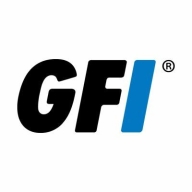
![Threat Stack Cloud Security Platform [EOL] Logo](https://images.peerspot.com/image/upload/c_scale,dpr_3.0,f_auto,q_100,w_64/o0no0it6ybl6satjcxomcblsgmd6.png)
Threat Stack Cloud Security Platform EOL and KerioControl are competing products that provide network security solutions. Threat Stack Cloud Security Platform EOL appears to have a competitive edge due to its comprehensive monitoring capabilities and valuable support, while KerioControl is notable for its ease of setup and intuitive management.
Features: Threat Stack Cloud Security Platform EOL offers real-time threat detection, continuous cloud monitoring, and integration with third-party tools, which enhance its cloud security focus. In contrast, KerioControl provides robust firewall protection, easy integration with VPNs, and detailed traffic management features, focusing on broader network security needs.
Room for Improvement: Threat Stack Cloud Security Platform EOL could improve its user interface and ease of use to reduce technical expertise requirements. Additionally, enhancement of its deployment and integration processes would benefit organizations with limited IT resources. KerioControl may refine its scalability, improve speed under heavy usage, and add more advanced threat detection features for wider applicability.
Ease of Deployment and Customer Service: KerioControl is known for its straightforward setup and responsive customer service, making it easier for non-technical users to deploy and manage. Threat Stack Cloud Security Platform EOL, while providing comprehensive documentation, requires more technical expertise, making it better suited for teams with a technological background.
Pricing and ROI: Threat Stack Cloud Security Platform EOL offers a flexible pricing model and the potential for a strong ROI, although initial costs may seem high. Conversely, KerioControl offers a budget-friendly initial cost and predictable ongoing expenses, promising a faster ROI for smaller operations with its extensive network security features.
I have never needed to contact customer support as the product is easy to use.
KerioControl has met some of the network infrastructure needs yet could improve in terms of scalability.
The price for the product is rated as ten out of ten.
The most valuable features include geo-tagging, which blocks all other IPs except for the specified accounts, and web filtering.

| Company Size | Count |
|---|---|
| Small Business | 44 |
| Midsize Enterprise | 9 |
| Large Enterprise | 3 |
| Company Size | Count |
|---|---|
| Small Business | 2 |
| Midsize Enterprise | 5 |
| Large Enterprise | 2 |
Kerio Control is a popular security product for small and medium-sized businesses. It is a next-generation firewall that provides unified threat management without complexity. Kerio Control provides advanced anti-virus protection and industry-leading web and content application filtering, and has a secure VPN.
With Kerio Control you can:
Kerio Control Features
Some of Kerio Control’s most valuable features include:
High availability, deployment flexibility, deep packet inspection, advanced routing, usage reporting, quick administering, intrusion detection and prevention (IPS), gateway anti-virus, VPN, web and content application filtering, and centralized administration with MyKerio.
Kerio Control Benefits
Reviews from Real Users
Here is some feedback from some of our users who are currently using the solution:
PeerSpot user Brian C., Senior Technology Specialist, VP at Unified Technology Solutions, writes "It is very comprehensive and simple. It has all the active protections. It's updated. We love that you can set how often it is updated so you can work on what is right for you. A large company with a lot of bandwidth can update the virus definitions and security definitions hourly, if they want. A smaller site that's remote, where maybe updating the definitions will eat into the bandwidth, we can schedule those more to go later at night. It's very flexible and works for us in all types of situations. This is great because then we don't have to learn seven different products to be able to work with seven different scenarios."
Andy D., IT Manager at Flare Technologies, praises how easy it is to use and says, "One thing we use quite a lot, as well, is the DHCP Server, because we do a lot of work where all our devices need to have static IP addresses. Rather than going around and configuring every box, we do it all through DHCP reservations. It's easier. We've got a record of it. We can manipulate it if we need to change something or change some hardware. It's all easy. Even guys who are not used to using it can pick it up quite quickly."
Threat Stack Cloud Security Platform [EOL] offers robust security features including endpoint monitoring, rule customization, and integration capabilities, with easy connectivity to cloud services like Docker and AWS.
Threat Stack Cloud Security Platform [EOL] provides tools for enhancing security visibility across cloud infrastructure. It supports AWS and Docker integration, facilitating efficient threat detection and management. Users appreciate its capability to configure customizable alerts and monitor endpoints, sessions, API interactions, and cloud services. However, there are areas needing improvement, such as better serverless environment support and reduced alert frequency. The platform services smaller organizations by compensating for limited security resources with its comprehensive monitoring and auditing tools.
What are the key features?In specific industries, Threat Stack Cloud Security Platform [EOL] is utilized for its strength in monitoring cloud infrastructure and preventing unauthorized access. Organizations in fields where cloud operations are critical use it for regular audits and monitoring. Its capabilities in threat management are leveraged to maintain secure operations and compliance, especially where there is no dedicated security team.
We monitor all Intrusion Detection and Prevention Software (IDPS) reviews to prevent fraudulent reviews and keep review quality high. We do not post reviews by company employees or direct competitors. We validate each review for authenticity via cross-reference with LinkedIn, and personal follow-up with the reviewer when necessary.